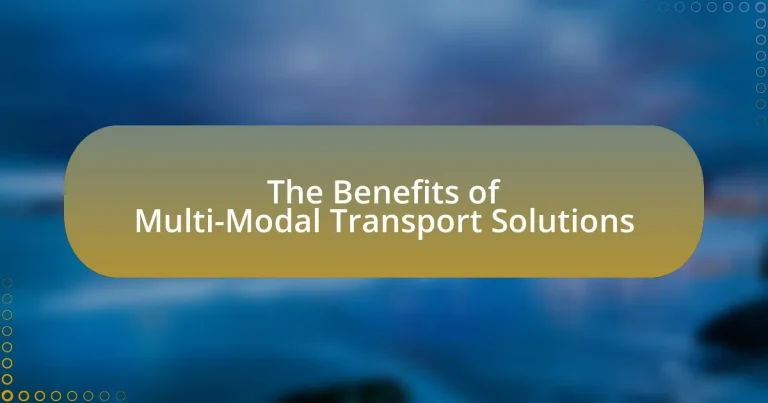Multi-Modal Transport Solutions are integrated transportation systems that utilize various modes, including road, rail, air, and sea, to enhance the efficiency of moving goods and passengers. This article outlines the functionality, importance, and benefits of multi-modal transport, highlighting how it reduces costs, improves delivery times, and addresses challenges faced by traditional transport methods. Key advantages include increased flexibility, reduced carbon emissions, and enhanced operational efficiency across industries such as logistics, e-commerce, and manufacturing. Additionally, the article discusses the role of technology in optimizing multi-modal strategies and the best practices companies can adopt for effective implementation.

What are Multi-Modal Transport Solutions?
Multi-Modal Transport Solutions are transportation systems that integrate multiple modes of transport, such as road, rail, air, and sea, to move goods or passengers efficiently. These solutions enhance logistical flexibility and optimize resource use by allowing seamless transitions between different transport modes. For instance, a study by the International Transport Forum highlights that multi-modal transport can reduce overall transportation costs by up to 20% and improve delivery times, demonstrating their effectiveness in modern logistics.
How do Multi-Modal Transport Solutions function?
Multi-Modal Transport Solutions function by integrating various modes of transportation, such as road, rail, air, and sea, to optimize the movement of goods and passengers. This integration allows for seamless transitions between different transport modes, enhancing efficiency and reducing costs. For instance, a shipment may travel by truck to a rail terminal, then by train to a port, and finally by ship to its destination. This method leverages the strengths of each transport mode, such as the speed of air transport and the cost-effectiveness of sea transport, to create a more efficient logistics network. The effectiveness of multi-modal transport is supported by data indicating that it can reduce transit times by up to 30% and lower transportation costs by 20% compared to single-mode transport.
What modes of transport are typically involved in Multi-Modal Solutions?
Multi-modal solutions typically involve a combination of road, rail, air, and maritime transport. These modes work together to optimize logistics and improve efficiency in the movement of goods and passengers. For instance, a common multi-modal transport scenario includes using trucks for last-mile delivery, trains for long-distance transport, and ships for international shipping, which collectively enhance supply chain effectiveness and reduce transit times.
How do these modes integrate to enhance efficiency?
Multi-modal transport solutions enhance efficiency by combining various transportation modes, such as road, rail, air, and sea, to optimize logistics and reduce transit times. This integration allows for seamless transitions between modes, minimizing delays and maximizing resource utilization. For instance, using rail for long-distance transport and trucks for last-mile delivery can significantly lower costs and carbon emissions, as evidenced by a study from the International Transport Forum, which found that multi-modal systems can reduce logistics costs by up to 30%. Additionally, real-time data sharing across modes improves coordination and responsiveness, further enhancing overall efficiency in supply chain operations.
Why are Multi-Modal Transport Solutions important in today’s logistics?
Multi-Modal Transport Solutions are important in today’s logistics because they enhance efficiency and flexibility in supply chain operations. By integrating various modes of transportation—such as road, rail, air, and sea—these solutions optimize routes and reduce transit times. For instance, a study by the International Transport Forum found that using multiple transport modes can decrease logistics costs by up to 15% while improving delivery speed. This adaptability allows businesses to respond quickly to market demands and disruptions, making multi-modal transport a critical component of modern logistics strategies.
What challenges do traditional transport methods face?
Traditional transport methods face significant challenges, including inefficiency, high operational costs, and environmental impact. For instance, road transport often suffers from traffic congestion, leading to delays and increased fuel consumption. According to the Texas A&M Transportation Institute, traffic congestion costs the U.S. economy over $166 billion annually in lost productivity. Additionally, traditional transport methods typically rely on fossil fuels, contributing to greenhouse gas emissions; the International Energy Agency reported that transport accounted for 24% of global CO2 emissions in 2021. These challenges highlight the need for more efficient and sustainable alternatives, such as multi-modal transport solutions.
How do Multi-Modal Solutions address these challenges?
Multi-Modal Solutions address transportation challenges by integrating various modes of transport to enhance efficiency and reduce costs. By combining road, rail, air, and maritime transport, these solutions optimize logistics, minimize transit times, and improve accessibility. For instance, a study by the International Transport Forum indicates that multi-modal transport can reduce greenhouse gas emissions by up to 30% compared to single-mode transport. This integration allows for better resource allocation and improved supply chain resilience, effectively tackling issues such as congestion and delays.

What are the key benefits of Multi-Modal Transport Solutions?
Multi-Modal Transport Solutions offer enhanced efficiency, cost-effectiveness, and flexibility in logistics. By integrating various transportation modes, such as road, rail, air, and sea, these solutions optimize routes and reduce transit times. For instance, a study by the International Transport Forum highlights that multi-modal systems can lower transportation costs by up to 30% while improving delivery speed. Additionally, they provide greater adaptability to changing market demands, allowing businesses to respond swiftly to customer needs. This combination of benefits makes multi-modal transport a strategic choice for modern supply chains.
How do Multi-Modal Transport Solutions improve cost efficiency?
Multi-Modal Transport Solutions improve cost efficiency by optimizing the use of different transportation modes to reduce overall logistics expenses. By integrating various transport methods, such as rail, road, and sea, companies can select the most cost-effective routes and modes for specific shipments, minimizing fuel costs and transit times. For instance, a study by the International Transport Forum found that using rail for long-distance transport can reduce costs by up to 30% compared to road transport alone. Additionally, multi-modal solutions can decrease the need for warehousing and handling, further lowering operational costs.
What factors contribute to cost savings in Multi-Modal transport?
Cost savings in multi-modal transport are primarily driven by optimized routing, reduced handling costs, and improved asset utilization. Optimized routing allows for the selection of the most efficient transport modes and paths, minimizing fuel consumption and transit times. Reduced handling costs arise from fewer transfers between modes, which decreases labor and equipment expenses. Improved asset utilization occurs as different transport modes can be used in tandem, maximizing the efficiency of vehicles and containers. According to a study by the International Transport Forum, multi-modal transport can reduce logistics costs by up to 20% compared to single-mode transport, demonstrating the financial benefits of these factors.
How does reduced transit time impact overall logistics costs?
Reduced transit time significantly lowers overall logistics costs by minimizing inventory holding expenses and enhancing supply chain efficiency. When transit times are reduced, companies can decrease the amount of capital tied up in inventory, as goods spend less time in transit and can be replenished more frequently. According to a study by the Council of Supply Chain Management Professionals, companies that optimize transit times can reduce their inventory carrying costs by up to 25%. Additionally, faster transit allows for improved customer satisfaction and potentially higher sales, as products reach consumers more quickly. This efficiency translates into lower operational costs, making reduced transit time a critical factor in effective logistics management.
In what ways do Multi-Modal Transport Solutions enhance flexibility?
Multi-Modal Transport Solutions enhance flexibility by integrating various transportation modes, allowing for optimized routing and scheduling. This integration enables shippers to select the most efficient combination of transport methods—such as road, rail, air, and sea—tailored to specific logistical needs. For instance, a study by the International Transport Forum highlights that using multiple transport modes can reduce transit times by up to 30%, demonstrating significant time savings and adaptability to changing circumstances. Additionally, the ability to switch between modes based on real-time conditions, such as traffic or weather, further increases operational flexibility, ensuring that goods are delivered in a timely manner regardless of unforeseen challenges.
How can businesses adapt their transport strategies using Multi-Modal Solutions?
Businesses can adapt their transport strategies using Multi-Modal Solutions by integrating various transportation modes to optimize efficiency and reduce costs. This approach allows companies to leverage the strengths of each mode, such as combining rail for long-distance transport with trucks for last-mile delivery, thereby enhancing flexibility and reliability. For instance, a study by the International Transport Forum indicates that using a combination of rail and road can reduce logistics costs by up to 30% while improving delivery times. By analyzing shipment data and customer needs, businesses can create tailored transport solutions that maximize resource utilization and minimize environmental impact.
What role does technology play in increasing flexibility?
Technology enhances flexibility by enabling real-time data sharing and communication across various transport modes. This integration allows for dynamic route adjustments, optimizing logistics and reducing delays. For instance, GPS tracking systems and mobile applications provide instant updates on traffic conditions and shipment status, facilitating quicker decision-making. According to a study by the International Transport Forum, the adoption of digital technologies in transport can lead to a 15% increase in operational efficiency, demonstrating the significant impact of technology on flexibility in multi-modal transport solutions.

What industries benefit most from Multi-Modal Transport Solutions?
The industries that benefit most from Multi-Modal Transport Solutions include logistics, e-commerce, manufacturing, and agriculture. These sectors leverage the flexibility and efficiency of combining different transportation modes, such as road, rail, air, and sea, to optimize their supply chains. For instance, logistics companies utilize multi-modal transport to reduce transit times and costs, while e-commerce businesses rely on it to ensure timely delivery of goods to customers across diverse locations. Manufacturing industries benefit from the ability to transport raw materials and finished products efficiently, and agriculture relies on multi-modal solutions to move perishable goods quickly to market.
How do different sectors utilize Multi-Modal Transport Solutions?
Different sectors utilize Multi-Modal Transport Solutions by integrating various transportation modes to enhance efficiency and reduce costs. For instance, the logistics sector combines road, rail, and maritime transport to optimize supply chain operations, allowing for faster delivery times and lower shipping expenses. The healthcare sector employs multi-modal transport to ensure timely delivery of medical supplies and equipment, utilizing air freight for urgent needs and ground transport for local distribution. Additionally, the retail sector leverages these solutions to manage inventory across multiple locations, using a combination of trucks and ships to balance speed and cost-effectiveness. These applications demonstrate the versatility and effectiveness of multi-modal transport in addressing the unique challenges faced by different industries.
What specific advantages do manufacturers gain from Multi-Modal transport?
Manufacturers gain several specific advantages from Multi-Modal transport, including cost efficiency, flexibility, and improved delivery times. Cost efficiency arises from the ability to select the most economical transport modes for different segments of the supply chain, which can significantly reduce overall logistics expenses. Flexibility is achieved through the integration of various transport methods, allowing manufacturers to adapt to changing market demands and optimize routes based on real-time conditions. Improved delivery times result from the strategic combination of air, sea, rail, and road transport, enabling faster movement of goods across diverse geographical areas. These advantages collectively enhance operational efficiency and competitiveness in the market.
How do retailers leverage Multi-Modal Solutions for supply chain efficiency?
Retailers leverage Multi-Modal Solutions for supply chain efficiency by integrating various transportation modes, such as road, rail, air, and sea, to optimize logistics operations. This integration allows retailers to reduce transportation costs, improve delivery times, and enhance flexibility in responding to market demands. For instance, a study by the Council of Supply Chain Management Professionals indicates that companies utilizing multi-modal transport can achieve up to a 20% reduction in logistics costs while increasing service levels. By strategically selecting the most efficient transport modes based on factors like distance, cost, and urgency, retailers can streamline their supply chains and improve overall operational efficiency.
What are the environmental benefits of Multi-Modal Transport Solutions?
Multi-Modal Transport Solutions significantly reduce environmental impact by optimizing energy efficiency and minimizing greenhouse gas emissions. By integrating various modes of transport, such as rail, road, and waterways, these solutions facilitate the use of the most efficient transport method for each segment of a journey. For instance, rail transport emits approximately 45% less carbon dioxide per ton-mile compared to road transport, highlighting the efficiency of combining modes. Additionally, multi-modal systems can decrease congestion and reduce reliance on single-occupancy vehicles, further lowering emissions. Studies indicate that cities implementing multi-modal transport strategies have seen a reduction in overall vehicle emissions by up to 30%, demonstrating the tangible environmental benefits of such systems.
How do Multi-Modal Solutions contribute to reduced carbon emissions?
Multi-modal solutions contribute to reduced carbon emissions by integrating various transportation modes, which optimizes efficiency and minimizes reliance on single modes that may have higher emissions. For instance, combining rail and road transport can significantly lower emissions per ton-mile compared to solely using trucks. Studies indicate that shifting freight from road to rail can reduce greenhouse gas emissions by up to 75%. Additionally, multi-modal systems encourage the use of public transport, cycling, and walking, further decreasing individual carbon footprints. By facilitating seamless transitions between different transport modes, these solutions enhance overall system efficiency and promote sustainable travel behaviors, leading to a measurable reduction in carbon emissions.
What sustainable practices are integrated into Multi-Modal transport?
Multi-modal transport integrates several sustainable practices, including the use of energy-efficient vehicles, promotion of public transit, and the incorporation of non-motorized transport options like cycling and walking. Energy-efficient vehicles, such as electric buses and hybrid trains, reduce greenhouse gas emissions and fuel consumption. Public transit systems, when utilized effectively, can significantly lower the number of individual car trips, thereby decreasing traffic congestion and pollution. Additionally, providing infrastructure for cycling and walking encourages healthier, low-impact travel options. According to the International Transport Forum, multi-modal transport can reduce transport-related emissions by up to 30% when effectively implemented.
What are the potential challenges of implementing Multi-Modal Transport Solutions?
Implementing Multi-Modal Transport Solutions faces several potential challenges, including integration complexity, infrastructure limitations, and regulatory hurdles. Integration complexity arises from the need to coordinate various transport modes, which can lead to inefficiencies if not managed properly. Infrastructure limitations often hinder the seamless transition between different transport modes, as existing facilities may not support multi-modal operations effectively. Regulatory hurdles can complicate the implementation process, as differing regulations across transport modes may create compliance issues. These challenges are supported by studies indicating that successful multi-modal systems require significant investment in technology and infrastructure to overcome these barriers.
What logistical hurdles might companies face when adopting Multi-Modal transport?
Companies adopting Multi-Modal transport may face logistical hurdles such as coordination challenges, regulatory compliance issues, and increased complexity in supply chain management. Coordination challenges arise from the need to synchronize different modes of transport, which can lead to delays if not managed effectively. Regulatory compliance issues stem from varying laws and regulations across regions and transport modes, complicating the shipping process. Additionally, the increased complexity in supply chain management requires companies to invest in technology and training to handle the integration of multiple transport methods efficiently. These hurdles can hinder the seamless implementation of Multi-Modal transport solutions.
How can businesses overcome these challenges effectively?
Businesses can effectively overcome challenges in multi-modal transport solutions by implementing integrated logistics strategies that enhance coordination among different transport modes. By utilizing technology such as real-time tracking systems and data analytics, businesses can optimize routes, reduce delays, and improve overall efficiency. For instance, a study by the International Transport Forum found that companies using integrated transport solutions can reduce logistics costs by up to 15% while improving delivery times. This demonstrates that leveraging technology and strategic planning is crucial for overcoming the complexities associated with multi-modal transport.
What best practices should companies follow when utilizing Multi-Modal Transport Solutions?
Companies should follow best practices such as integrating technology, optimizing routes, and ensuring effective communication when utilizing Multi-Modal Transport Solutions. Integrating technology, such as transportation management systems, enhances visibility and tracking across different transport modes, leading to improved efficiency. Optimizing routes through data analysis can reduce transit times and costs, as evidenced by studies showing that route optimization can decrease fuel consumption by up to 20%. Effective communication among all stakeholders, including carriers and customers, ensures that everyone is informed about schedules and potential delays, which is crucial for maintaining service reliability. These practices collectively enhance operational efficiency and customer satisfaction in multi-modal transport.
How can businesses optimize their Multi-Modal transport strategies?
Businesses can optimize their multi-modal transport strategies by integrating advanced technology for real-time tracking and data analytics. This integration allows for better visibility across the supply chain, enabling businesses to make informed decisions regarding route optimization and resource allocation. For instance, using platforms that consolidate data from various transport modes can enhance efficiency by identifying the most cost-effective and timely routes. Additionally, adopting collaborative logistics practices, such as sharing resources with other companies, can further reduce costs and improve service levels. According to a study by the International Transport Forum, companies that leverage technology in their logistics operations can reduce transportation costs by up to 15%.
What tools and technologies are recommended for effective Multi-Modal transport management?
Effective multi-modal transport management is facilitated by tools and technologies such as Transportation Management Systems (TMS), Geographic Information Systems (GIS), and real-time tracking solutions. TMS enables the planning, execution, and optimization of the physical movement of goods, while GIS provides spatial analysis and mapping capabilities essential for route planning and logistics. Real-time tracking solutions, including GPS and RFID technologies, enhance visibility and coordination across different transport modes, ensuring timely deliveries and efficient resource allocation. These tools collectively improve operational efficiency, reduce costs, and enhance customer satisfaction in multi-modal transport scenarios.


